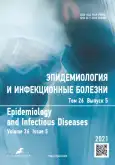Vol 26, No 5 (2021)
- Year: 2021
- Published: 19.08.2022
- Articles: 4
- URL: https://rjeid.com/1560-9529/issue/view/5170
- DOI: https://doi.org/10.17816/EID.265
Original study articles
Toxicity profile of the new compound XC221GI from pre-clinical studies
Abstract
The major feature of COVID-19 is intensive virus-induced inflammation in vital body organs and spatiotemporal dysregulation of pro- and anti-inflammatory cytokines and chemokines synthesis. All this leads to unpredicted clinical progression and high risk of "cytokine storm" development. The "cytokine storm" is the pathogenetic basis for further development of life-threatening complications. Thus, there is a huge need to select effective and safe approaches that allow to control virus-induced inflammation as a part of preventive anti-inflammatory therapy.
This article presents toxicological characteristics of the original low-molecular compound XC221GI (1-[2-(1-methylimidazole-4-yl)-ethyl]perhydroazin-2,6-dione) from pre-clinical studies.
The obtained results demonstrate that the XC221GI does not have any toxic effect in repeated long-term administration. The compound was well tolerated by all animals. The no-observed-adverse-effect level (NOAEL) was 30 mg/kg per day for dogs and 450 mg/kg per day for rats. There were no effects of XC221GI on blood count, hematopoiesis and hemostasis. As well as no cytotoxic, mutagenic, genotoxic, carcinogenic properties or anaphylactogenic and immunotoxic activity were revealed for XC221GI. All known data enable to classify XC221GI as a low toxic compound and consider its safety profile as reasonably favorable.
 200-213
200-213


Reviews
Features of nosocomial infections in patients with severe burn injury
Abstract
Nosocomial infections in patients with burn injury is one of the leading problems of modern healthcare. In terms of prevalence, they exceed those in patients with any other pathology. In the conditions of man-made disasters and in everyday life, violation of safety rules leads to burn injury.
To study the prevalence of nosocomial infections in patients with burns, identify risk factors and evaluate the effectiveness of the existing system of epidemiological surveillance of these infections, an analysis of publications on this topic on several information resources was carried out: eLibrary.ru, Google Scholar, PubMed and NCBI.
It was found that the most common form of nosocomial infections in burn patients is a burn wound infection, which is treated by 38.8%, lower respiratory tract infections, including those associated with ventilation aids (19.7%), are in the second position, and bloodstream infections (8.1%) are in the third position. Urinary tract infections do not occupy such a significant place, however, their significant prevalence among patients outside the intensive care and intensive care units has been noted in foreign literature. Despite the available data on the prevalence of certain clinical forms of nosocomial infections, data on risk factors and a number of problematic issues that may be the subject of discussion and require their solution remain controversial. The risks of death are high due to the specifics of burn injury, with its frequent combination with inhalation trauma.
The system of epidemiological surveillance of nosocomial infections in burn centers, including in the intensive care and intensive care units, has some differences in approaches to identifying, recording, registering, and collecting information about the place and time of the greatest risk.
 214-223
214-223


Laboratory diagnosis of Yersinia pseudotuberculosis and Yersinia enterocolitica
Abstract
Enteropathogenic species Yersinia pseudotuberculosis and Yersinia enterocolitica are of great importance worldwide due to their ability to survive and preserve pathogenic properties in biotic and abiotic environments. They can cause sporadic and flare-up diseases. Therefore, it is extremely important to use modern methods of diagnosing diseases caused by these pathogens.
The article analyzes the methods of laboratory diagnostics of enteropathogenic Yersinia (Y. pseudotuberculosis and Y. enterocolitica), including bacteriological, serological and molecular genetic. Modern data on the use of the polymerase chain reaction method, mass spectrometry (МALDI-TOF MS), dot immunoassay are presented. The scheme of the optimal protocol for the detection and identification of Yersinia is given.
The combination of classical microbiological and molecular genetic methods quickly determines the presence or absence of a pathogen in a sample, which allows the bacteriological study to be purposefully used to verify the clinical diagnosis, confirm transmission factors and plan anti-epidemic measures.
 224-237
224-237


Epidemiological characteristics of bloodstream infection in patients with somatic diseases
Abstract
In 1999, at the conference of the European Working Group on Nosocomial Infections, the term "bloodstream infection" was proposed in the presence of clinical symptoms and microorganisms in the bloodstream. The first classification of bloodstream infection consisted of 3 categories: hospital, iatrogenic and out-of-hospital. Then theywere classified into 5 categories. At the same time, bloodstream infection that occurred during the first 48 hours after the patient's admission to the medical organization were divided into 4 groups (A–D). "Group C" included bacteremia associated with invasive procedures and was classified into 5 subgroups.
The number of episodes of IR. The number of episodes of bloodstream infection in the world is growing depending on the geographical location of the country (from 1995 to 2002 increased by 40%, by 2007 ― by 14.3%). Among the sources of infection, the role of the respiratory, hepatobiliary, gastrointestinal, urogenital and urinary tracts, the presence of intravascular devices and pneumonia. Bloodstream infection is characterized by frequent infestation of men, staphylococcal etiology, catheter-association, and the presence of comorbid diseases. Re-episodes of Gram-negative bloodstream infection are more likely to occur within 3 months. Until 2004, Staphylococcus aureus was the leading pathogen of bloodstream infection; after 2005, Escherichia coli dominated.
These two pathogens succeeded each other in different years. Currently, pathogens of bloodstream infection in patients with therapeutic profile are gram-positive cocci, including CNS, S. aureus, enterococci, fungi and anaerobes. Bloodstream infection is characterized by polymicrobiality (35.7%), including bacterial-fungal (22%).
 238-247
238-247












